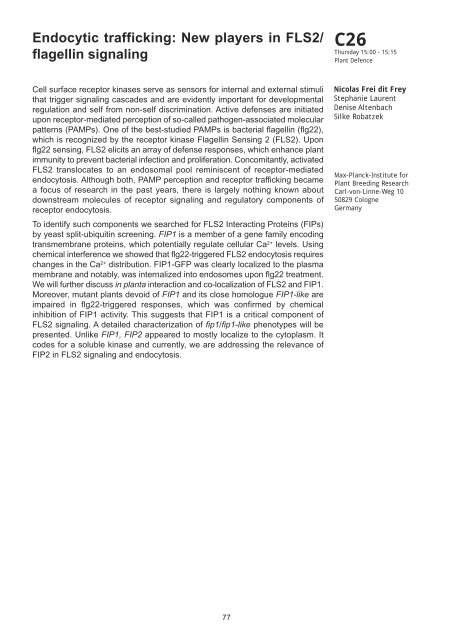Edinburgh, Scotland, United Kingdom - TAIR
Edinburgh, Scotland, United Kingdom - TAIR
Edinburgh, Scotland, United Kingdom - TAIR
You also want an ePaper? Increase the reach of your titles
YUMPU automatically turns print PDFs into web optimized ePapers that Google loves.
Endocytic trafficking: New players in FLS2/<br />
flagellin signaling<br />
Cell surface receptor kinases serve as sensors for internal and external stimuli<br />
that trigger signaling cascades and are evidently important for developmental<br />
regulation and self from non-self discrimination. Active defenses are initiated<br />
upon receptor-mediated perception of so-called pathogen-associated molecular<br />
patterns (PAMPs). One of the best-studied PAMPs is bacterial flagellin (flg22),<br />
which is recognized by the receptor kinase Flagellin Sensing 2 (FLS2). Upon<br />
flg22 sensing, FLS2 elicits an array of defense responses, which enhance plant<br />
immunity to prevent bacterial infection and proliferation. Concomitantly, activated<br />
FLS2 translocates to an endosomal pool reminiscent of receptor-mediated<br />
endocytosis. Although both, PAMP perception and receptor trafficking became<br />
a focus of research in the past years, there is largely nothing known about<br />
downstream molecules of receptor signaling and regulatory components of<br />
receptor endocytosis.<br />
To identify such components we searched for FLS2 Interacting Proteins (FIPs)<br />
by yeast split-ubiquitin screening. FIP1 is a member of a gene family encoding<br />
transmembrane proteins, which potentially regulate cellular Ca2+ levels. Using<br />
chemical interference we showed that flg22-triggered FLS2 endocytosis requires<br />
changes in the Ca2+ distribution. FIP1-GFP was clearly localized to the plasma<br />
membrane and notably, was internalized into endosomes upon flg22 treatment.<br />
We will further discuss in planta interaction and co-localization of FLS2 and FIP1.<br />
Moreover, mutant plants devoid of FIP1 and its close homologue FIP1-like are<br />
impaired in flg22-triggered responses, which was confirmed by chemical<br />
inhibition of FIP1 activity. This suggests that FIP1 is a critical component of<br />
FLS2 signaling. A detailed characterization of fip1/fip1-like phenotypes will be<br />
presented. Unlike FIP1, FIP2 appeared to mostly localize to the cytoplasm. It<br />
codes for a soluble kinase and currently, we are addressing the relevance of<br />
FIP2 in FLS2 signaling and endocytosis.<br />
77<br />
C26<br />
Thursday 15:00 - 15:15<br />
Plant Defence<br />
Nicolas Frei dit Frey<br />
Stephanie Laurent<br />
Denise Altenbach<br />
Silke Robatzek<br />
Max-Planck-Institute for<br />
Plant Breeding Research<br />
Carl-von-Linne-Weg 10<br />
50829 Cologne<br />
Germany




